Just a few highlights at the Ranch & Coast Classic include Friday’s $10,000 USHJA International Hunter Derby and Saturday’s $10,000 1.40M Jumper Classic and $50,000 Grand Prix of California. Competitive until the final horse galloped on course, these three events welcomed well over a hundred horses onto the gorgeous grass field at the Del Mar Horse Park.$10,000 USHJA International Hunter Derby
Qualifying for the Handy round of the $10,000 USHJA International Hunter Derby required a cumulative first round score of 169 or better. The challenges of the Handy Round included a snake vertical, galloping up a hill, a trot jump and galloping down the hill to an oxer option. Although some illustrated classic hunter style, Yellow Dog Farm’s Crown Affair and John French proved their handy prowess, scoring a solid ten points higher than any other round. The thirteen-year-old Holsteiner stallion moved up from 10th after the first round for the win.
“I wasn’t sure if it was his day after the first round,” explained owner Gail Morey. “But he really perked up for the next round, he just loves to be handy!”
Second to Crown Affair was Davlyn Farm’s Come Monday, with Christa Endicott in the irons. Still green at the Derby level, the mare has a fabulous jump and no doubt will be a recognizable name in the hunter ranks.
$10,000 1.40m Jumper Classic
Of the thirty-eight horses who entered the $10,000 1.40M Jumper Classic, eleven were clean and the top five spots went to up and coming young riders. Last to go, Karl Cook aboard Lavito (owned by Signe Ostby) took the top prize away from Paris Sellon on her Orlando LA, when he stopped the clock a mere half a second faster. Coming in a close third, just a half a second slower than Sellon was fourteen year old Kara Chad of Canada on Stone Ridge’s Alberto. College freshman Saer Coulter rounded out the top five on her two mounts Atticus and Asgard.
$50,000 Grand Prix of California
The $50,000 Grand Prix of California hosted thirty-eight horse and rider duets onto the grass field at the Del Mar Horse Park. Venezuelan course designer Leopoldo Palacios challenged riders and horses alike setting a flowing course that demanded a keen eye and technically accurate ride. With plenty competitors garnering time and jumping faults, nine riders managed to navigate the first round with a clean score.
When designing the course for the $50,000 competition, Palacios said it was very important to him to understand the level of every horse and rider in the class.
“I believe this show is one of the biggest events on the west coast and I’m building big so those who are winning, are winning at the top national level,” noted Palacios.
In addition to his challenging courses, Palacios is also known for his setting tight times. Originally, competitors were not to exceed 79 seconds but after a few riders encountered time faults, an adjustment to 81 seconds saved many riders from faults. Third to go in the jump-off, Hutchison galloped Cantano around Palacios’ shortened track with the win in mind, knowing she would have to put in a quick and accurate ride to leave all the jumps in place. Stopping the clock at 36.56, nearly ten seconds under the time allowed Hutchison was able to do just that. The pair are truly in sync, as they enter their third grand prix season, this is their fifteenth win to date.
“Leopoldo is one of the best course designers around,” said Hutchison. “He has a tight time and sets to par which challenges the sport, making the riders and horses better. It’s what we need.”
Also earning a place in the jump-off and ending the day double clear, veteran riders Helen McNaught and Hap Hansen battled it out for second and third place honors. Navigating the shortened track second to last, Hansen masterfully piloted Archie Bunker (Linda Smith) to stop the clock in 39.20 seconds. Hansen seemingly had the second place finish secured until last to go McNaught and her own Caballo shaved one more second off the clock to finish in 38.12, bumping Hansen to third. Michelle Spadone and Uwwalon (Morgan Hill Partners) were the first pair to navigate the first round track without fault and did so again when they entered the ring for the jump-off, crossing the timers in 40.19 seconds for fourth. As the last double clear ride of the afternoon, Kirsten Coe rode Kilkenny Randall Z (Ilan Ferder) to the fifth position in a time of 40.54.
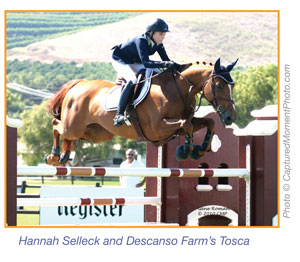 Thirty-three horse and rider duos stepped up (or in some cases down) to the challenge of the Leopoldo Palacios designed course in the $35,000 Summer Classic II Grand Prix, presented by Equ Lifestyle Magazine. Of all those who had aspirations of going clean, only the first two on course, Lane Clarke aboard Bay Rose’s Nikko and Hannah Selleck riding the fiery mare Tosca of Descanso Farm, were able to do so. Both young and ambitious, it was twenty-one-year-old Selleck who came out on top with a stellar double clear ride for the win.
Thirty-three horse and rider duos stepped up (or in some cases down) to the challenge of the Leopoldo Palacios designed course in the $35,000 Summer Classic II Grand Prix, presented by Equ Lifestyle Magazine. Of all those who had aspirations of going clean, only the first two on course, Lane Clarke aboard Bay Rose’s Nikko and Hannah Selleck riding the fiery mare Tosca of Descanso Farm, were able to do so. Both young and ambitious, it was twenty-one-year-old Selleck who came out on top with a stellar double clear ride for the win.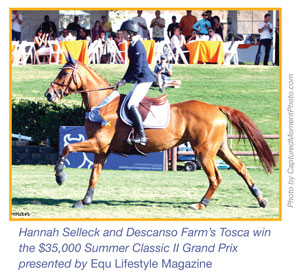 As the rest of the competitors took to the course, Palacios’ challenge was evident. All remaining exhibitors picked up faults of some kind – rails fell, time allowed was exceeded, hooves landed in the water, and refusals, run-outs and accidental dismounts also occurred.
As the rest of the competitors took to the course, Palacios’ challenge was evident. All remaining exhibitors picked up faults of some kind – rails fell, time allowed was exceeded, hooves landed in the water, and refusals, run-outs and accidental dismounts also occurred. Representing the West Coast, Duncan McFarlane piloted the eight-year-old Mr. Whoopy to an impressive eighth place finish, dropping just one rail on course, and Helen McNaught rode Caballo to the thirteenth position with an eight fault score.
Representing the West Coast, Duncan McFarlane piloted the eight-year-old Mr. Whoopy to an impressive eighth place finish, dropping just one rail on course, and Helen McNaught rode Caballo to the thirteenth position with an eight fault score. The WEG is here!
The WEG is here!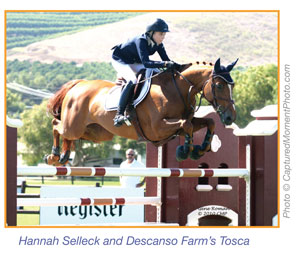 Thirty-three horse and rider duos stepped up (or in some cases down) to the challenge of the Leopoldo Palacios designed course in the $35,000 Summer Classic II Grand Prix, presented by Equ Lifestyle Magazine. Of all those who had aspirations of going clean, only the first two on course, Lane Clarke aboard Bay Rose’s Nikko and Hannah Selleck riding the fiery mare Tosca of Descanso Farm, were able to do so. Both young and ambitious, it was twenty-one-year-old Selleck who came out on top with a stellar double clear ride for the win.
Thirty-three horse and rider duos stepped up (or in some cases down) to the challenge of the Leopoldo Palacios designed course in the $35,000 Summer Classic II Grand Prix, presented by Equ Lifestyle Magazine. Of all those who had aspirations of going clean, only the first two on course, Lane Clarke aboard Bay Rose’s Nikko and Hannah Selleck riding the fiery mare Tosca of Descanso Farm, were able to do so. Both young and ambitious, it was twenty-one-year-old Selleck who came out on top with a stellar double clear ride for the win.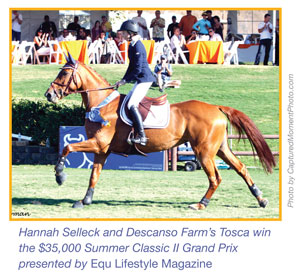 As the rest of the competitors took to the course, Palacios’ challenge was evident. All remaining exhibitors picked up faults of some kind – rails fell, time allowed was exceeded, hooves landed in the water, and refusals, run-outs and accidental dismounts also occurred.
As the rest of the competitors took to the course, Palacios’ challenge was evident. All remaining exhibitors picked up faults of some kind – rails fell, time allowed was exceeded, hooves landed in the water, and refusals, run-outs and accidental dismounts also occurred.



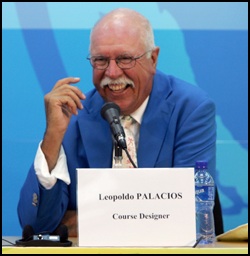 How did you become a course designer? What is your horse history?
How did you become a course designer? What is your horse history?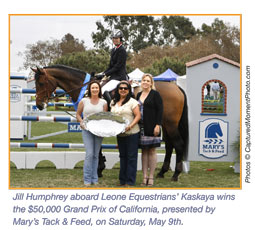 Palacios left no room for error, keeping riders on their toes from the first turn to the last line. Although the rollback turn from one to two seemed straight forward, it was the initial spot where time was wasted and often could not be made up later in the course. The last line paralleled the in-gate in a steady seven strides to a triple that rode long in one to a sizeable gate oxer to another long two stride followed by a turn away from the in-gate to a big square oxer. The first rider to negotiate the course without a rail went fifth in the line-up, Gretchen Lof aboard Zambezi (Kings Wood Farm, LLC). However she stopped the clock at 79.41 resulting in three time faults, and a fifth place finish. Following her round, one or more rails dropped and time faults accrued until the twenty-second pair, Will Simpson aboard Nadia (Gotham Enterprises, LLC), galloped through the timers completely clean. Shortly after, Jill Humphrey and Kaskaya (Leone Equestrians Inc.) did the same. Twenty-ninth in the ring, Guy Thomas and Urian (Vicki Juelsgaard), joined the jump-off participants and not until the thirty-ninth horse, Veronica Tracy on her mount Muscadet De La Saveniere, did we have the fourth clean ride.
Palacios left no room for error, keeping riders on their toes from the first turn to the last line. Although the rollback turn from one to two seemed straight forward, it was the initial spot where time was wasted and often could not be made up later in the course. The last line paralleled the in-gate in a steady seven strides to a triple that rode long in one to a sizeable gate oxer to another long two stride followed by a turn away from the in-gate to a big square oxer. The first rider to negotiate the course without a rail went fifth in the line-up, Gretchen Lof aboard Zambezi (Kings Wood Farm, LLC). However she stopped the clock at 79.41 resulting in three time faults, and a fifth place finish. Following her round, one or more rails dropped and time faults accrued until the twenty-second pair, Will Simpson aboard Nadia (Gotham Enterprises, LLC), galloped through the timers completely clean. Shortly after, Jill Humphrey and Kaskaya (Leone Equestrians Inc.) did the same. Twenty-ninth in the ring, Guy Thomas and Urian (Vicki Juelsgaard), joined the jump-off participants and not until the thirty-ninth horse, Veronica Tracy on her mount Muscadet De La Saveniere, did we have the fourth clean ride.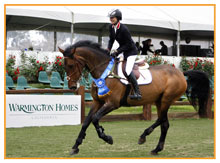 Four-faulters placed sixth through twelfth; the top of that pack was Susie Hutchison on Cantano (El Dorado 29) who went lightning fast with just one rail. Third time in the ring was a charm for Guy Thomas when clean aboard Urian, having his share of ups and downs with four entries including a fall off Midnight Dance (Alec Lawler), one rail on Carino (Willow Tree Farm, Inc.), and just one rail on Peterbilt (Peterbilt, LLC). Although possibly a touch sore on Sunday, Saturday was still worth celebrating for Thomas and Willow Tree, finishing with three in the top twelve (see results below).
Four-faulters placed sixth through twelfth; the top of that pack was Susie Hutchison on Cantano (El Dorado 29) who went lightning fast with just one rail. Third time in the ring was a charm for Guy Thomas when clean aboard Urian, having his share of ups and downs with four entries including a fall off Midnight Dance (Alec Lawler), one rail on Carino (Willow Tree Farm, Inc.), and just one rail on Peterbilt (Peterbilt, LLC). Although possibly a touch sore on Sunday, Saturday was still worth celebrating for Thomas and Willow Tree, finishing with three in the top twelve (see results below).